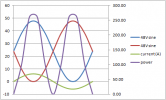@jst, here are a few simple but hopefully useful points about amplifier power:
1) An amplifier can output
different power levels. They are defined by the volume knob, that is tied to an internal feedback loop that limits the output current at the desired volume [power] level. At every such volume, the amplifier outputs some current
I.
2) As a sine wave, this current is
I=
Io*sin(ωt+ϕ), with its mean value
Irms=
Io/√2.
3) For power estimation, it's fine to assume a purely
resistive speaker load
R (the number from the speaker spec - "4Ohm", "8Ohm".) [This resistive load is responsible for electric-current energy transfer to external - acoustic and heat - energy.]
4) So, for a volume level the [per-channel] amplifier ["sustained, continuous"] output power
P will be
P=R*Irms^2. This is the formula for the amplifier output power.
5) Now, for a given volume, the amplifier output voltage (
Vo and
Vrms) is a fraction of its max output
Vmax. (It's defined by the speaker
R and the current from (1) per Ohm's law.) However, unlike a simple transistor, the output
Vmax of a Class D amp is NOT necessarily limited by the input [power supply] DC voltage ("
VDC") - as eg the amplifier can work in a "bridging" mode
internally doubling this input voltage.
6) Similarly, the amplifier input DC current (aka power supply output current , limited by PS' max [DC] current "rating") does not necessarily limit/relates to the amplifier output [AC] current [neither
Io or
Irms from (2)]. Instead, the only relation is through preservation of energy:
R*
Irms_max^2
<= VDC*
Imax / 2 (2 channels).

